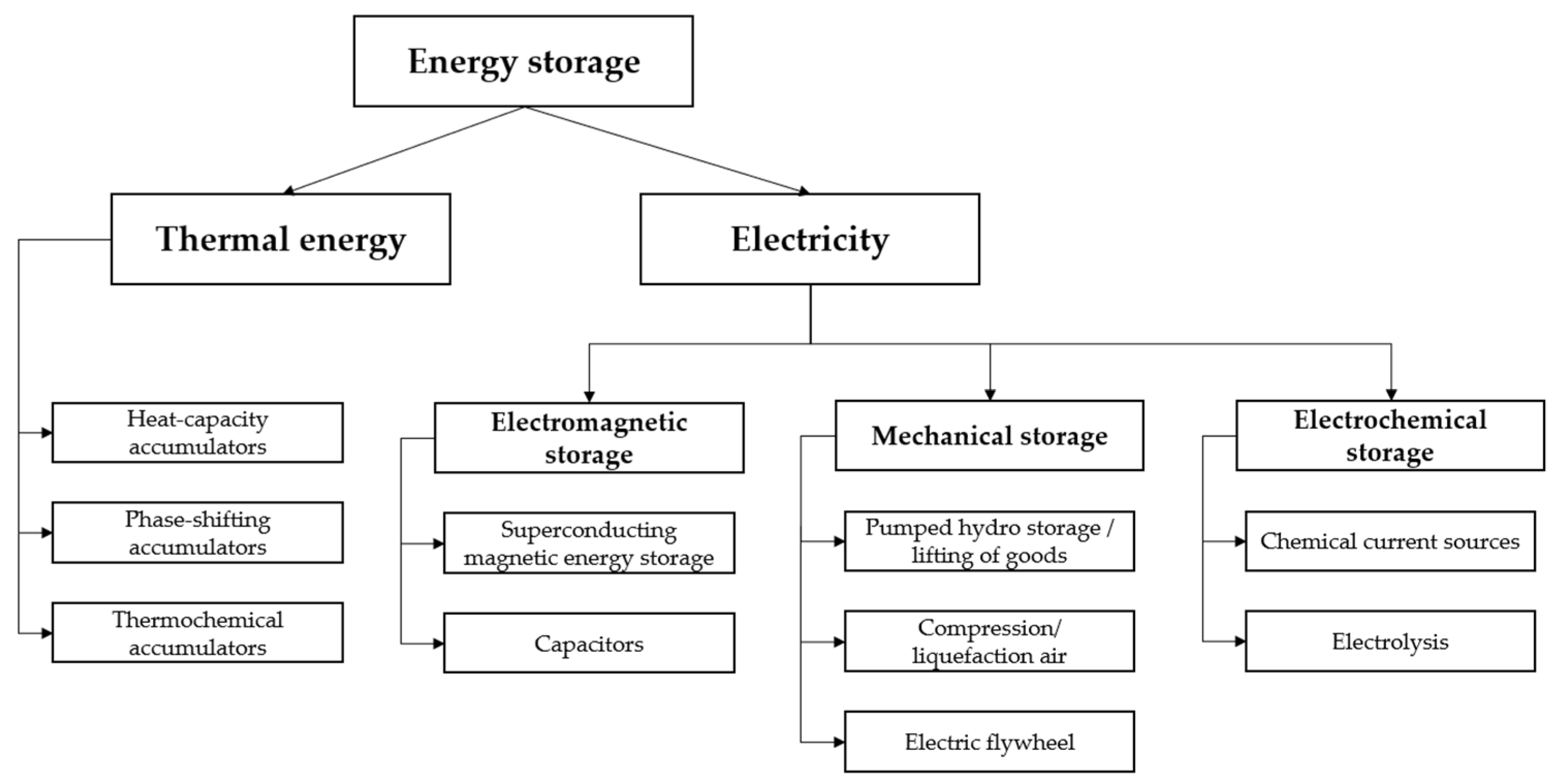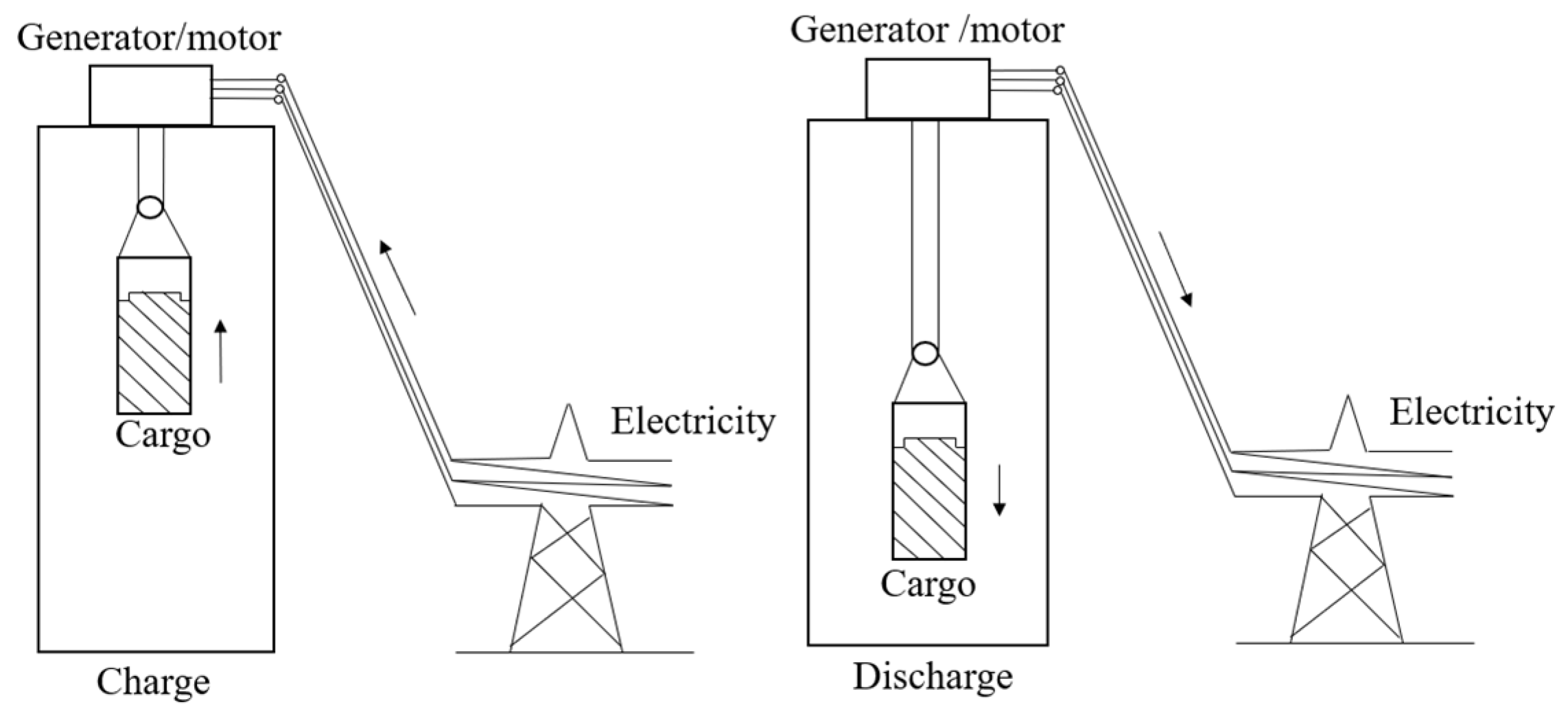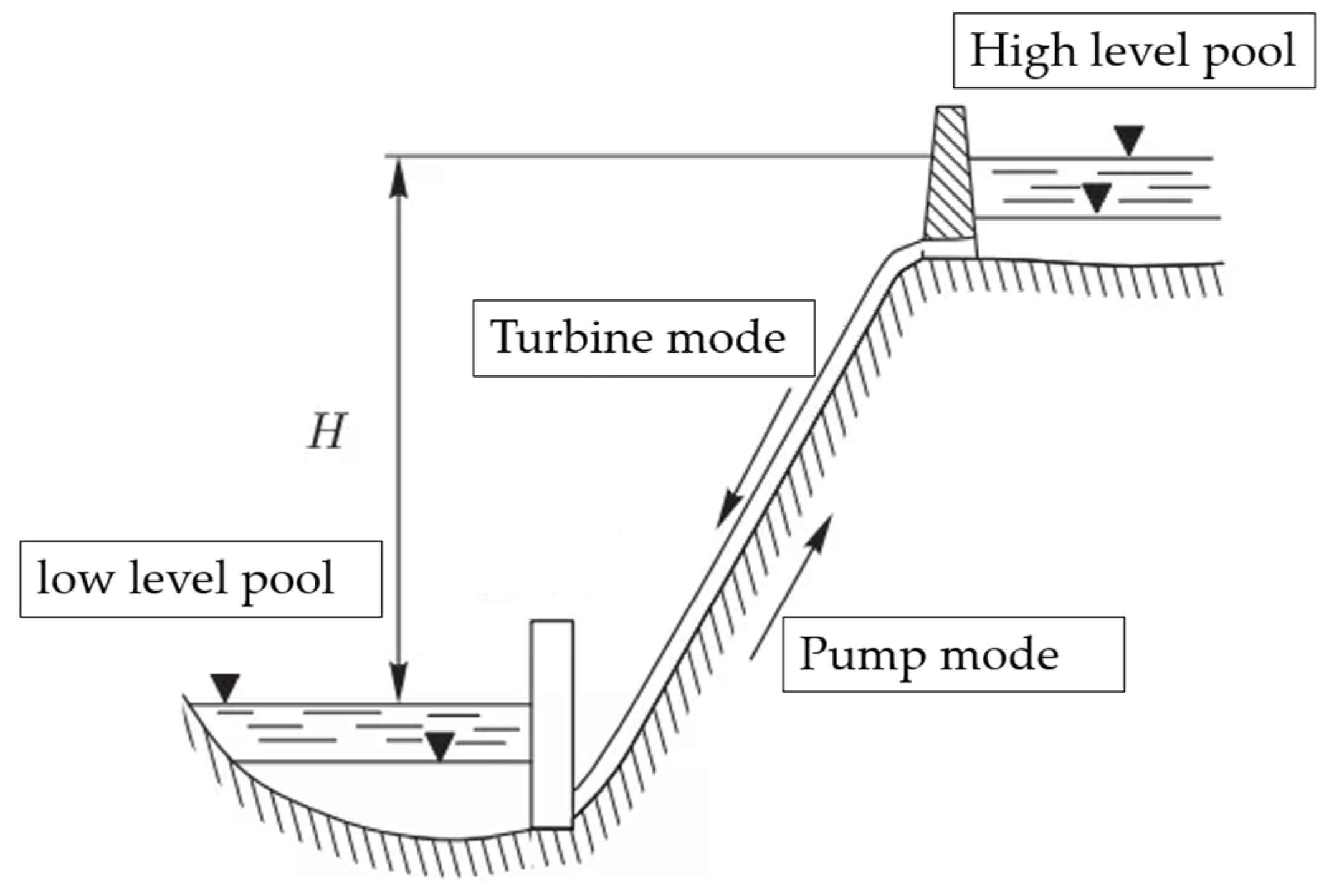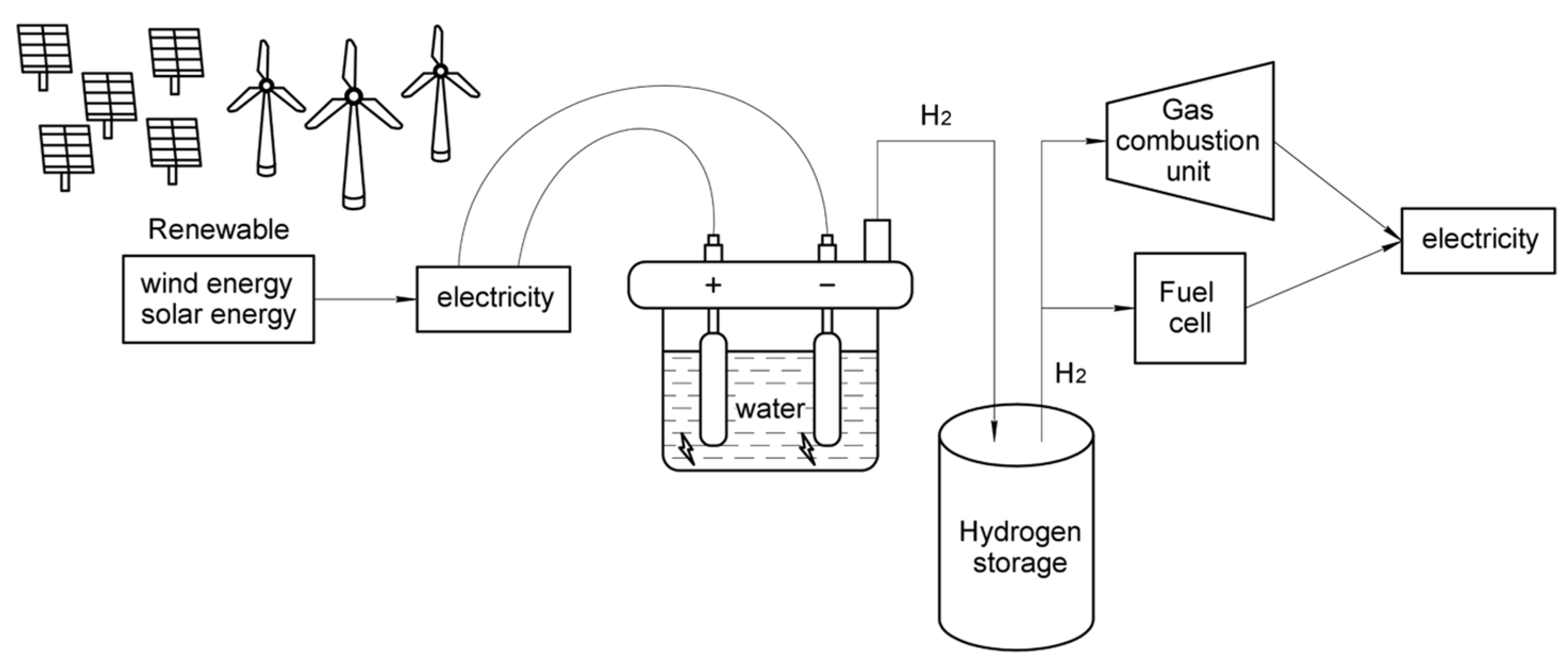You're using an outdated browser. Please upgrade to a modern browser for the best experience.
Please note this is an old version of this entry, which may differ significantly from the current revision.
The daily non-uniform power demand is a serious problem in power industry. In addition, recent decades show a trend for the transition to renewable power sources, but their power output depends upon weather and daily conditions. These factors determine the urgency of energy accumulation technology research and development. The presence of a wide variety of energy storage mechanisms leads to the need for their classification and comparison as well as a consideration of possible options for their application in modern power units.
- energy storage
- hydrogen energy
- energy systems
1. Introduction
1.1. Relevance of the Development and Introduction of Energy Storage Systems
The rapid increases in world population and industrialization have caused an increase in power consumption. The International Energy Agency data show a power consumption growth of more than 36% in the last 20 years [1]. This has led to the active development of thermal and electric power production technology, transport, storage, and consumption. New renewable sources of technology, experimental power production facilities which run on traditional hydro-carbon fuels with zero harmful emissions [2], and R&D works on hydrogen power production [3] are all being developed.
The increase in renewable power sources is part of a global trend in the industry. New solar, wind, and other facilities are being constructed and entering operation. The portion of these sources in the world power production balance is 28%, and this will grow in the near future. The main factors that determine this trend are the number of practically inexhaustible primary energy sources and the prospect of almost zero harmful atmospheric emissions. On the other hand, the inconstancy in terms of supplied energy and its direct relationship with weather conditions, i.e., wind or clouds, remarkably limit the direct use of renewable sources in power supply systems.
A key feature of power supply system operation is power demand time non-uniformity. Uneven electric power consumption during daytime, week, and year periods requires the operation of production facilities with similar non-uniform loads. Modern thermal and nuclear power plants operating on steam–water energy cycles are by far the most common sources of power supply and are characterized by relatively low maneuverability in terms of the main equipment. Their operation in dynamic and low loads modes causes faster equipment wear and lower reliability and efficiency, which results in increased energy supply costs. In nuclear facilities, dynamic operation of reactor circuits is impossible because of design-specific features.
These factors bring about the necessity of creating the conditions for system load smoothening. Here, one of the prospective directions is the introduction of energy accumulation systems to stabilize the power consumption and production and to expand the controllability ranges of low maneuverability facilities [4]. These systems may cover system peak loads by using the energy accumulated during low power consumption periods (Figure 1a) or by using the constant power of the facility (Figure 1b) [5][6][7]. In the electricity market, accumulation systems may accumulate energy during the low price periods and supply it during the higher demand periods at higher electricity prices [8][9].

Figure 1. Accumulation system operation in a power grid: (a) load leveling; (b) peak shaving.
1.2. Energy Storage Methods Classification
The energy accumulation principle is based on the transformation of primary energy into a form that is easier to accumulate and store as well as its further transformation into a customer-acceptable form (Figure 2). The accumulation process may consist of sequential transformation elements or of direct accumulation without transformation, for example, the accumulation of water in a municipal heat supply system. Nowadays, the methods of energy accumulation differ with the type of primary energy and storage form.

Figure 2. Energy transformation sequence of an accumulation system.
The classification of accumulation methods is necessary because of the variety of methods. The classification approaches are based on the stored energy type, the forms of consumed and supplied energy, the storage capacity, or the form of primary energy. Figure 3 presents the classification by primary energy type of the accumulation methods that may be applied to power supply systems. The accumulation systems may be split into electrical or thermal primary energy forms. The thermal energy supplied to the system may be accumulated in the form of heat capacity internal energy or the heat carrier storage in heat insulation systems, for example, accumulating tanks in a city water network. These are known as heat capacity accumulation systems. Another method involves the application of thermal energy to a special material, such as salt alloys or low melt metals, so as to change the material. This so-called phase transition accumulator method uses phase transition internal heat. Another prospective technology is known as thermochemical energy accumulation, whereby thermal energy is used in a reversible chemical reaction and the energy is accumulated via the storage of reaction products.

Figure 3. Classification of energy storage systems.
Another class of accumulation system may be defined as the transformation of primary electrical energy by electro-magnet accumulators, which store energy in the form of electrical or magnet fields. Mechanical accumulators transform electrical energy into the potential or kinetic energy of a working substance. Electro-chemical accumulators store the energy via chemical processes.
The performance of the mentioned accumulation methods may be described by their specific energy transformation sequences, maximal capacities, power, costs, etc. The application of methods to a power production systems ought to be preceded by an analysis of the performance and specific features of existing and prospective accumulation methods, the possible versions available, and the methods of introducing them into power production systems.
2. Methods for Electric Energy Accumulation
If the primary energy is electricity, it may be accumulated in the form of an electromagnetic field. The energy may be accumulated in magnetic field form promoted by a superconductive coil (superconducting magnetic energy storage—SMES). This system can promptly release its energy into a grid. The use this type of accumulator for grid operation support is promising [10]. However, these systems are not widely used because of the necessity to keep the temperature low in the superconductive coils, which results in high costs [11].
Capacitors and supercapacitors accumulate energy in the form of an electrical field formed between electrodes by a potentials difference. Such devices may produce up to high power levels but their capacity is smaller than that of other systems [12] and the cost for 1 kWh storage may be too high, making this accumulation method uncompetitive [13].
Additionally, electric energy may be transformed into the potential or kinetic mechanical energy of various solid bodies. The Figure 4 shows an accumulating facility that uses electricity to lift a massive object. This facility accumulates potential energy by lifting the load against gravity forces, with the load descending to discharge electricity production [14]. This technology can be used separately from energy systems, where the special materials are used as cargo, or it can be integrated into technological processes at facilities and enterprises where it is necessary to frequently lift and release various objects [15]. There are works that consider the use of gravitational energy storage systems with the integration of renewable energy sources [16][17]. The authors of [18] analyzed the prospect of using of a gravitational energy storage system in existing shafts of hard coal mines in Poland. The authors found that the obtained economic effects of the solution were low, and therefore there was no economic justification for activities related to its implementation.

Figure 4. Gravitational energy storage system.
The pumped hydroelectric energy storage (PHES) principle is similar. A PHES uses either a set of generators and pumps or a convertible hydroelectric facility that can operate in generator or pump modes (Figure 5). During the power consumption drop which occurs at night, the PHES system takes power from an electric grid and uses it to pump water into the pool located high up. During peak power consumption in the morning and afternoon, the PHES system releases water from the high pool to a lower one, producing electricity and supplying it into a grid. Modern PHES systems exhibit 60–80% efficiency [19].

Figure 5. Pumped hydroelectric energy storage.
The remarkably large amount of accumulated energy is limited by the pool volume. Nowadays. PHES systems are widely used and make up over 96% of world energy accumulation storage [20]. In addition to its high capacity, a PHES system can produce high power at high discharge velocities. Furthermore, this method has almost zero storage losses or a nearly zero self-discharge level. The shortcoming of this method is the necessity of the facility to be located nearby to a water source and the necessity of a water pond buildup, which may be environmentally harmful and capital intensive because of the water pond levels.
Certain projects store electricity in the form of compressed air potential energy (compressed air energy storage—CAES). Electricity drives an air compressor that supplies compressed atmospheric air to accumulator vessels. In high-capacity systems, the compressed air is usually stored in natural caverns or salt caves (Figure 6). For system discharge, the high-pressure air is supplied to a combustor or to an air heater, and then the energy is utilized in a gas turbine [21].

Figure 6. Compressed air energy storage system.
Nowadays, at least six CAES projects have been introduced and at least seven projects are being developed (Table 1). The existing CAES projects have a maximal power of 290 MW (Huntorf plant) and a 2860 MWh capacity (McIntosh) [22]. Nearly all operating CAES systems store air in salt caves [23].
Table 1. Operating and planned CAES projects.
| Location | Year | Power, MW | Capacity, MWh | Efficiency, % |
|---|---|---|---|---|
| Operating CAES projects | ||||
| Huntorf plant, Germany | 1978 | 290 | 580 | 42 |
| McIntosh, Alabama | 1991 | 110 | 2860 | 54 |
| Gaines, Texas | 2012 | 2 | - | - |
| Goderich, Ontario | 2019 | 2.2 | 10 | - |
| Jiangsu, China | 2022 | 60 | 300 | 60 |
| Zhangjiakou, China | 2022 | 100 | 400 | 70.4 |
| Sardinia, Italy | 2022 | 2.5 | 4 | - |
| Planned (and unrealized) CAES projects | ||||
| Bakersfield, California | 2009 | 300 | - | - |
| Watkins Glen, New York | 2010 | 150 | - | - |
| Essen, Germany | 2013 | 200 | 1040 | 70 |
| Cheshire, Britain | 2017 | 40 | 800 | - |
| Northern Ireland | 2019 | 330 | - | - |
| New South Wales, Australia | 2022 | 200 | 1600 | - |
| San Luis Obispo, California | 2022 | 400 | 3200 | - |
| Rosamond, California | 2022 | 500 | 4000 | - |
In addition to the transformation of electricity into potential energy, certain systems transform it into kinetic energy, specifically into flywheel rotation energy. An electric motor rotates a massive body located in a vacuum pit. The friction losses are small, so the flywheel shaft saves its rotation energy for a time. In the discharge, this energy is spent for the electricity generator drive [24]. The capacity of such accumulators is mostly determined by the flywheel mass and size, so these systems are not widely used. The flywheel can store energy for a short amount of time, and these systems have a high degree of self-discharge. The maximum storage period usually does not exceed 1 h, so this technology has not been widely used in power systems and complexes.
Electric energy may be accumulated in a secondary power source or an electric accumulator. This method is widely used in modern devices, from domestic gadgets to transport. In the power industry, accumulators are not so widely used, especially in high-capacity systems. Most of the projects of this type are based on the application of lithium-ion accumulators. Lithium-ion batteries have a high energy density, high efficiency, and low self-discharge. Existing storage projects based on the operation of Li-ion batteries can develop a discharge power of up to 100 MW, with their round-trip efficiency reaching 95% [25]. Another important advantage of these batteries is their high specific mass and volume capacity.
This is due to the advantages and efficiency of this type of system. To compare the capacities and power parameters of different chemical batteries, lithium-ion accumulators have the best capacity and specific power and smallest self-discharge degree. Because of these advantages, most existing high-power projects use systems of this type.
Electrolysis facilities with hydrogen fuel accumulation are also a prospective energy accumulation direction. These systems use electricity for water electrolysis and hydrogen production. The hydrogen is stored in storage systems, vessels, or natural subterranean cavities. Then, electricity is produced by hydrogen combustion in a gas turbine or in a fuel cell (Figure 7) [26]. The accumulation capacity is directly determined by the amount of stored hydrogen. The power of the facility is determined by the electrolyzer and gas turbine or the fuel cell performance.

Figure 7. Hydrogen energy accumulation scheme.
This technology is promising due to the possibility of a large amount of energy being stored and a high-power capacity. In [27], the authors showed that the hydrogen storage capacity may be equal to or even higher than a PHES system. However, this technology has many problems which are yet to be solved concerning the production, transportation, and storage of hydrogen fuel. Furthermore, the high capital costs of the main components of hydrogen storage systems (fuel cells and electrolyzers) is one of the key problems concerning their implementation in the energy sector [28]. Although the system’s efficiency is still comparatively low, hydrogen accumulation system technology is a prospective R&D direction [29].
This entry is adapted from the peer-reviewed paper 10.3390/en15249541
References
- Global Energy Review 2021; International Energy Agency: Paris, France, 2021; p. 36.
- Allam, R.; Martin, S.; Forrest, B.; Fetvedt, J.; Lu, X.; Freed, D.; Brown, G.W.; Sasaki, T.; Itoh, M.; Manning, J. Demonstration of the Allam Cycle: An Update on the Development Status of a High Efficiency Supercritical Carbon Dioxide Power Process Employing Full Carbon Capture. Energy Procedia 2017, 114, 5948–5966.
- Abe, J.O.; Popoola, A.P.I.; Ajenifuja, E.; Popoola, O.M. Hydrogen Energy, Economy and Storage: Review and Recommendation. Int. J. Hydrog. Energy 2019, 44, 15072–15086.
- Vazquez, S.; Lukic, S.M.; Galvan, E.; Franquelo, L.G.; Carrasco, J.M. Energy Storage Systems for Transport and Grid Applications. IEEE Trans. Ind. Electron. 2010, 57, 3881–3895.
- Chua, K.H.; Lim, Y.S.; Morris, S. Energy Storage System for Peak Shaving. Int. J. Energy Sect. Manag. 2016, 10, 3–18.
- Sun, Y.; Wang, S.; Xiao, F.; Gao, D. Peak Load Shifting Control Using Different Cold Thermal Energy Storage Facilities in Commercial Buildings: A Review. Energy Convers. Manag. 2013, 71, 101–114.
- Argyrou, M.C.; Christodoulides, P.; Kalogirou, S.A. Energy Storage for Electricity Generation and Related Processes: Technologies Appraisal and Grid Scale Applications. Renew. Sustain. Energy Rev. 2018, 94, 804–821.
- Schoenung, S.M.; Eyer, J.M.; Iannucci, J.J.; Horgan, S.A. Energy Storage for a Competitive Power Market. Annu. Rev. Energy Environ. 1996, 21, 347–370.
- Lund, H.; Salgi, G.; Elmegaard, B.; Andersen, A.N. Optimal Operation Strategies of Compressed Air Energy Storage (CAES) on Electricity Spot Markets with Fluctuating Prices. Appl. Therm. Eng. 2009, 29, 799–806.
- Buckles, W.; Hassenzahl, W.V. Superconducting Magnetic Energy Storage. IEEE Power Eng. Rev. 2000, 20, 16–20.
- McLarnon, F.R.; Cairns, E.J. Energy Storage. Annu. Rev. Energy 1989, 14, 241–271.
- Ribeiro, P.F.; Johnson, B.K.; Crow, M.L.; Arsoy, A.; Liu, Y. Energy Storage Systems for Advanced Power Applications. Proc. IEEE 2001, 89, 1744–1756.
- Zakeri, B.; Syri, S. Electrical Energy Storage Systems: A Comparative Life Cycle Cost Analysis. Renew. Sustain. Energy Rev. 2015, 42, 569–596.
- Ruoso, A.C.; Caetano, N.R.; Rocha, L.A.O. Storage Gravitational Energy for Small Scale Industrial and Residential Applications. Inventions 2019, 4, 64.
- Alkubaisi, Y.; Hasan, W.; Noor, S.M.; Kadir, M.A.; Harun, H.R.; Sabry, A. Control Mechanism of Automated Dropper System for Electric Power Generation. In Proceedings of the 2017 IEEE 3rd International Symposium in Robotics and Manufacturing Automation (ROMA), Kuala Lumpur, Malaysia, 19–21 September 2017; pp. 1–5.
- Botha, C.D.; Kamper, M.J. Linear Electric Machine-Based Gravity Energy Storage for Wind Farm Integration. In Proceedings of the 2020 International SAUPEC/RobMech/PRASA Conference, Cape Town, South Africa, 29–31 January 2020; pp. 1–6.
- Haider, S.; Shahmoradi-Moghadam, H.; Schönberger, J.O.; Schegner, P. Algorithm and Optimization Model for Energy Storage Using Vertically Stacked Blocks. IEEE Access 2020, 8, 217688–217700.
- Kulpa, J.; Kamiński, P.; Stecuła, K.; Prostański, D.; Matusiak, P.; Kowol, D.; Kopacz, M.; Olczak, P. Technical and Economic Aspects of Electric Energy Storage in a Mine Shaft—Budryk Case Study. Energies 2021, 14, 7337.
- Ibrahim, H.; Ilinca, A.; Perron, J. Energy Storage Systems—Characteristics and Comparisons. Renew. Sustain. Energy Rev. 2008, 12, 1221–1250.
- Khan, N.; Dilshad, S.; Khalid, R.; Kalair, A.R.; Abas, N. Review of Energy Storage and Transportation of Energy. Energy Storage 2019, 1, e49.
- Wang, J.; Lu, K.; Ma, L.; Wang, J.; Dooner, M.; Miao, S.; Li, J.; Wang, D. Overview of Compressed Air Energy Storage and Technology Development. Energies 2017, 10, 991.
- Mattick, W.; Haddenhorst, H.; Weber, O.; Stys, Z.S. Huntorf: The World’s First 290-MW Gas Turbine Air-Storage Peaking Plant. . In Proceedings of the Annual American Power Conference, Chicago, IL, USA, 21 April 1975; Volume 37.
- Budt, M.; Wolf, D.; Span, R.; Yan, J. A Review on Compressed Air Energy Storage: Basic Principles, Past Milestones and Recent Developments. Appl. Energy 2016, 170, 250–268.
- Amiryar, M.E.; Pullen, K.R. A Review of Flywheel Energy Storage System Technologies and Their Applications. Appl. Sci. 2017, 7, 286.
- Zhang, C.; Wei, Y.-L.; Cao, P.-F.; Lin, M.-C. Energy Storage System: Current Studies on Batteries and Power Condition System. Renew. Sustain. Energy Rev. 2018, 82, 3091–3106.
- Ozarslan, A. Large-Scale Hydrogen Energy Storage in Salt Caverns. Int. J. Hydrog. Energy 2012, 37, 14265–14277.
- Aneke, M.; Wang, M. Energy Storage Technologies and Real Life Applications–A State of the Art Review. Appl. Energy 2016, 179, 350–377.
- Komorowska, A.; Olczak, P.; Hanc, E.; Kamiński, J. An Analysis of the Competitiveness of Hydrogen Storage and Li-Ion Batteries Based on Price Arbitrage in the Day-Ahead Market. Int. J. Hydrog. Energy 2022, 47, 28556–28572.
- Barthélémy, H.; Weber, M.; Barbier, F. Hydrogen Storage: Recent Improvements and Industrial Perspectives. Int. J. Hydrog. Energy 2017, 42, 7254–7262.
This entry is offline, you can click here to edit this entry!
